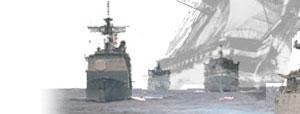

Welcome to the my Father-in-Law's and best friends David Brockman's War story, created by Mark Maloney. This page is dedicated to my Father-in-Law, Richard Jackson. who was a Merchant Marine in World War II, seeing combat in Guadelcanal; and the pacific, 42-46. David Served in Vietnam aboard the Aircraft Carrier, Forestal, 1969.

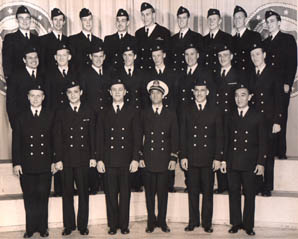 |
| Lt.JG R.Jackson (2nd row, 4th from left) |
Heroes and their Gallant Ships
Merchant mariners were on the front lines the moment their
ships left U.S. ports, are were subject to attack by bombers,
kamikaze, battleships, submarines, mines, and land-based artillery.
Old time mariners received their gunnery training at the nearest
port when gunnery training became necessary. Robert Perez
of San Jose, CA received his gunnery training in Australia. Maurice
Breen, who shot down a German bomber, received British Merchant
Navy gunnery training in Great Britain. The U.S. Maritime Service
provided gunnery training for all its recruits.
Countless mariners performed acts of bravery and heroism beyond
the call of duty. The Distinguished Service Medal, the
Merchant Marine's highest honor, was awarded to mariners,
of whom 7 were cadets from the U.S. Merchant Marine Academy.
Ten ships were recipients of the Gallant Ship Award.
| Distinguished Service Medal |
Service beyond the call of duty |
2,379 |
| Meritorious Service Medal |
Meritorious conduct or service |
1,362 |
| Mariner's Medal |
Dead or wounded |
5,578 |
| Combat bar |
Under enemy attack |
10,879 |
| War Zone bar |
Service in war zone |
100,567,000 |
Prisoners of War
Both, men and women Mariners became Prisoners of War.
Some, like Stan Willner and George Duffy
were prisoners of both the Germans and the Japanese, including
the notorious River Kwai camps. The first mariner POW's
were the crew of the SS President Harrison who were captured
by the Japanese on December 7, 1941.
Who Were the Mariners?
In 1940 the Merchant Marine numbered
about 4,000. A massive recruiting effort brought in retired
seafarers who were able to ship out immediately on the newly launched
Libertys. Among them were who
served as cook on the SS Joshua Hendy. Thomas Cavely,
former master on the Brooklyn to Staten Island ferry, served as
captain of a Liberty ship.
Young mariners trained at the U.S.
Merchant Marine Academy, various state Maritime Academies,
or the U.S. Maritime Service Training Stations. William
Travers, 22, was captain of the SS James Ford Rhodes,
while his 21 year old brother was first mate. The U.S. Maritime
Service officially took youngsters who were 16 years-old.
They took them with one eye, one leg, or heart problems.
An informal survey of six WWII mariners
about their reason for joining the Maritime Service or Merchant
Marine before or during the war, elicited the following reasons
(all were 16 to 18 years old at the time):
 | Saw the movie "Action on the North
Atlantic" starring Humphrey Bogart.
 | Built Liberty Ships for 3 months, and
wanted to sail in one.
 | Didn't pass the physical for Naval
Academy or West Point, but was accepted by a Maritime Academy.
 | Was in the Conservation Corps, which
sent him to the newly formed U.S. Maritime Service.
 | Loved geography in school and wanted
to see the world.
 | Sent to U.S. Maritime Service by
a Navy recruiter, who said that was where his service was needed.
| | | | | |
 Naval Armed Guard Naval Armed Guard
In October 1941, the U. S. Navy organized an Armed Guard
to provide gun crews for duty aboard the country's 1,375 merchant
ships, just as it had done in World War I. The first Armed Guard
were given their 3 weeks of training at Little Creek, Virginia
and the first trainees and their officers were ready to sail in
November 1941, when Congress repealed the Neutrality Act. By war's
end, Armed Guard training bases were located throughout the country,
and over 144,900 men served on over
American and Allied ships. Nearly 2,000 of these men gave their lives in
defense of their of their country.
According to Armed Guard veteran William Schofield in
"Eastward the Convoys," Navy gun crews aboard
merchant ships. . . won literally thousands of decorations and
commendations for bravery. At a heavy cost of life, they had delivered
to foreign shores the millions of tons of supplies and munitions
without which the war against the Axis Powers could not have been
won."
Schofield quotes from a voyage report to Murmansk, which gives
a good picture of the hazards faced by Armed Guard and their shipmates:
"We passed through heavy ice fields. . . At 1235, the
Convoy Commodore's ships was torpedoed and sank in less than one
minute. We were next in column, and we passed a number of survivors
in the water, about 30 of them. [Merchant ships were forbidden
to stop in convoy for rescue.]. . . Early in the morning, the
convoy was attacked by 4 torpedo planes, but no ships were hit.
At about 1300 hours, enemy surface craft were sighted. Our 4 accompanying
destroyers immediately laid a smoke screen on the side from which
they were approaching, and all merchant ships equipped with smoke
pots lit them off. There were 3 German destroyers in the enemy
group and they made 5 attempts to destroy our convoy but were
driven off each time. During the battle, one of our ships was
hit and sunk. Later the convoy passed though a thick ice pack
and escaped in a heavy snowstorm."
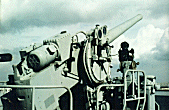 Another voyage report from the Mediterranean: Another voyage report from the Mediterranean:
"Our ship was part of the invasion force and went in close
to the beach with the original landing. We were subjected to shelling
from the enemy land positions. . . we had 27 actual bombings from
enemy aircraft. The gun crew was on emergency watch for those
8 days, obtaining very little rest. . . several gunners were wounded.
. . an enemy ME-109 came diving at our ship. The gunners filled
her with 20-millimeter shells and the plane burst into flame,
crashing into the ship's side and exploding. . . The ship took
water rapidly. . . so we ran her onto the beach to avoid sinking.
. . The Navy gun crew stayed at their battle stations, sleeping
and eating there, so that the ship might be protected and the
cargo that was so badly needed on the beach could be safely discharged."
[Photo shows gun on SS Lane Victory]
In November 1942, near Trinidad, the SS Nathaniel Hawthorne
was torpedoed, exploding and sinking within two minutes, taking
39 men down with her, among them Armed Guard officer Kenneth
Muir. One of the 10 survivors saw Muir, his arm blown off
at the shoulder, pushing 3 men to the stern and forcing them to
jump off the blazing ship, then going back to rescue others.
Lt. Kenneth M. Willet, was the officer in charge of
the Armed Guard unit on the SS Stephen Hopkins when she
was attacked by the heavily armed German raiders Stier
and Tannenfels.
Willet was hit several times by shrapnel as he commanded the
gunners and helped man the 4-inch stern gun. The Stier was heavily
damaged. Then the ammunition magazine exploded and Willet abandoned
the gun to help release life rafts. The SS Stephen Hopkins sank
stern first, taking Lt. Kenneth Willet with her. [Cadet Edwin
O'Hara fired the last shells in the gun, sinking the Stier.]
For more about the Armed Guard, visit http://www.armed-guard.com/

Salary for Mariners Equivalent
to Other Services
During World War II, some gossip columnists claimed that merchant
mariners were getting rich on outrageous salaries. In a 1943 letter
to the American Legion, Admiral Telfair Knight of the War Shipping
Administration compared salaries for equivalent positions
in Navy and Merchant Marine, and found salaries to be equivalent
or even higher for Navy personnel. In addition, the Navy offered
outstanding benefits, including paid leave, disability and death
benefits, free medical care for personnel and dependents, free
uniforms, and a generous retirement pension.
Mariners signed on for each voyage which lasted until they
returned to a U.S. port, which could be one year or more. They
had no paid leave, no vacation and no pension.
Salary Comparison
Navy vs. Merchant Marine
Liberty Ships

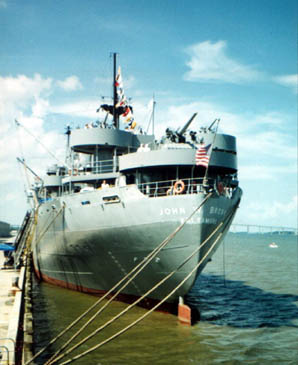
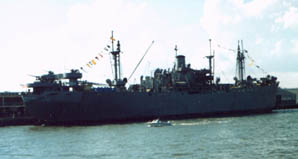
Upon seeing the design for the Liberty ship which was based
on a British ship first built in 1879, President Roosevelt named
her "the ugly duckling."
The first of the 2,700 Liberty ships was the SS Patrick Henry,
launched on Sept. 27, 1941, and built to a standardized, mass
produced design. The 250,000 parts were pre-fabricated all over
the country and the 250-ton sections, complete with portholes
and mirrors, were miraculously welded together in as little as
four and a half days. A Liberty cost under $2,000,000.
The Liberty (officially an EC2) was 441 feet long and 56 feet
wide. Her three-cylinder, reciprocating steam engine, fed by two
oil-burning boilers produced 2,500 hp and a speed of 11 knots.
Her 5 holds could carry over 9,000 tons of cargo, plus airplanes,
tanks, and locomotives lashed to its deck. A Liberty could carry
2,840 jeeps, 440 tanks, or 230 million rounds of rifle ammunition.
Libertys carried a crew of about 44 and 12 to 25 Naval Armed
Guard.
Some were armed with:
 | One 4 inch stern gun
 | Two 37 mm bow guns
 | Four .50 caliber machine guns
 | Two .30 caliber machine guns
| | | |
About 200 Libertys were lost to torpedoes, mines, explosions,
kamikazes, etc. during WWII. Two Liberty ships, the SS Jeremiah
O'Brien in San Francisco and the SS John W. Brown in Baltimore,
survive as "museum ships" open to the public
for tours and occasional cruises.
Victory Ships
The Liberty's maximum speed was 11 knots, making her eas y prey
for submarines, so early in 1942 designs for a 15 knot ship were
begun. The first of 534 Victory ships, the SS Uni ted Victory,
was launched on February 28 1944, and like the Libertys, used
production line techniques. The next 34 Victory ships were named
for each of the Allied nations; the subsequent 218 were named
after American cities, the next 150 were named after educational
institutions, and rest received miscellaneous names.
The Victory ship (officially VC2) was 455 feet long and 62
feet wide. Her cross-compound steam turbine with double reduction
gears developed 6,000 or 8,500 horsepower. Her design was sleek
- compared to the Liberty - and her hull was strengthened to avoid
the fractures which plagued the Liberty. Victorys were armed with:
 | One 5 inch stern gun
 | One 3 inch bow gun
 | Eight 20 mm machine guns
| | |
The SS Lane Victory in San Pedro, CA is open to the
public for tours, occasional cruises, and can often be seen in
movies and commercials. This floating museum was named after Isaac
Lane who was born into slavery and later founded Lane College
in Jackson, Tennessee [Alex Hailey, author of "Roots"
is a famous alumnus]. The Red Oak Victory
is being restored in Richmond, CA.
 Tankers Tankers
Tankers were developed around the turn of the century to carry
liquid cargo: gasoline, oil, or molasses. During World War II,
American tankers made 6,500 voyages to carry 65 million tons of
oil and gasoline from the U.S. and the Caribbean to the war zones
and to our Allies. They supplied 80% of the fuel used by bombers,
tanks, jeeps and ships during the War.
The T-2 was the workhorse of the tanker fleet:
 | feet long
 | foot beam
Speed 16 knots
| |
A typical tanker crew included 42 mariners and 17 Navy Armed
Guard. Tankers carried between 90,000 and 140,000 barrel liquid
capacity.
In 1943, desperate for cargo capacity, "skeleton decks"
about 7 or 8 feet above the deck (to keep the planes out of the
waves and to make lashing simpler) were attached to many tankers
to enable them to carry planes and PT boats to the front.
Immediately after Pearl Harbor, when the U.S. declared
war on Germany and Japan, the U-Boats arrived on our Atlantic
Seaboard. They concentrated on the tanker fleet, knowing how essential
fuel was to the war effort. Americans faced rationing of gasoline
for their cars and heating oil for their homes, to spare fuel
for the war front.
The tanker SS Cedar Creek, was lend-leased to the USSR.
O.M. 'Jac' Smith and two other Americans were asked to
join the Soviet crew to bring the ship to the USSR. Because of
a series of misunderstandings, the three shipmates found themselves
in a Soviet labor camp. Jac Smith escaped from the camp
located outside Archangel (Arkhanhelsk), and with the help of
Laplanders who found him nearly unconscious in the snow and the
Norwegian underground, traveled 900 miles to freedom. He traveled
through German-occupied Norway and then by fishing boat to Great
Britain.
Mines and Degaussing
Hundreds of ships were sunk or badly damaged from mines planted
by planes, minelayers, and submarines in the North Sea, English
Channel, and Mediterranean Sea. German submarines also laid mines
in the Delaware River, Chesapeake Bay, Boston, Charleston, Jacksonville
and New York harbo rs. The Germans counted on the submarine to
win the war at sea, with the mine an important "assist."
The Japanese heavily mined the waters of th eir homeland and
their conquered territories throughout Asia. These mines did not
distinguish betwe en ships, nor did they recognize V-E or V-J Day
as the end of war.
Mine Clearing Job to End Next Year, British Report
(New York Times, March 30, 1946)
London. Northwest European waters will not be cleared of mines
to make them completely safe for shipping until the summer of
1947, the Admiralty announced today. The British coast should
be completely cleared by June or July of this year. Since the
end of the war in Europe seventy-two merchantmen and fishing
vessels of all nationalities have been sunk or damaged in European
waters.
(New York Times, Aug. 25,
1946)
Tokyo. Pacific mariners were warned today that some 30,000 mines
had broken loose from Japanese minefields and were floating in
trade currents. The mines explode by magnetic or pressure influence
and remain dangerous to shipping for five years.
The magnetic mine
was the most dangerous and destructive type. All steel ships have
magnetism built into them. When a steel vessel passes over a magnetic
mine, the magnetic forces in the ship trigger a mechanism in the
mine that sets off an explosion under the hull.
To counteract these mines, some ships were degaussed.
Thick bands of electrical wire, aligned with the main deck, were
fastened around the length of the vessel. The wire was energized
with an electric current that neutralized the ship's magnetism.
This system saved countless numbers of ships from destruction.

SS Black Point -- Last U-boat Victim of the War on May 5, 1945
off Point Judith, Rhode Island.
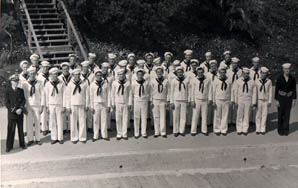 |
| R.Jackson-(2nd row, 2nd from left) |
         
|
![]()



 Naval Armed Guard
Naval Armed Guard Another voyage report from the Mediterranean:
Another voyage report from the Mediterranean:


